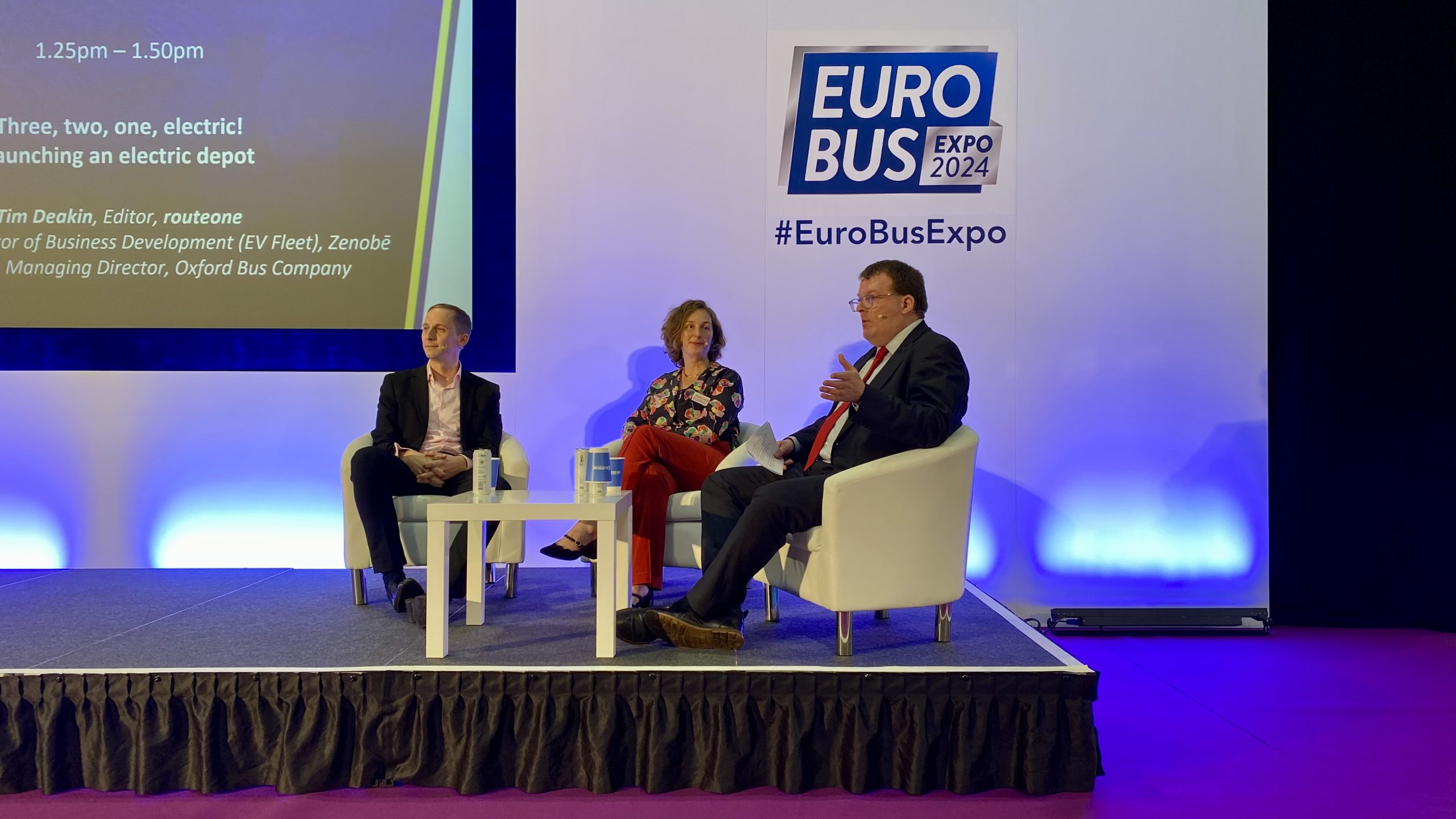Behind the scenes: launching an electric depot

The transition to electric often means a steep learning curve. How are other bus leaders tackling the job of switching, while keeping things running smoothly?
Read Luke Marion of Oxford Bus Company’s account of shaping their impressive project, and find out his advice for the transition.
This is an edited transcript of a discussion on the Masterclass Stage at Euro Bus Expo in November 2024. If you prefer to watch the original session, you can view it on the event website, here: https://eurobusxpo.com/masterclass-theatre/masterclass-on-demand/
The electric bus depot: a smooth-running system
Oxford Bus Company has no fewer than 104 electric buses, all in service since August 2024. To support the vehicles, it’s invested in the chargers and cabling to provide power, as well as associated services. Luke explains,
“Zenobē are maintaining the charging hubs, and they give us a warranty on that. That includes the high voltage electrical checks, and maintenance of the chargers.
So if we damage chargers with injudicious vehicle movements, Zenobē are on hand to assist us. Equally, components can fail, and Zenobē can do that on the warranty as well.
[And] they also provide software, so we have a system to assess the [power] load management. We use the software to give us kind of an ‘eye in the sky’ in the garage office overnight, when the buses are all on charge.
The software will show us where they are in the yard, and what percentage [charge] they’re on. The controller will get alerted if one of them is not charging or is not reaching the level of percentage that we think it should.
So we don’t have to wander around the yard looking for a specific bus and making sure they’re all tucked up nicely for the night.”
Peace of mind for batteries, a new type of asset
But there’s a far more important aspect to the service, which Luke was keen to get right from the outset. Thinking about the risks he identified during the preparation phase, there was one thing that stood out. He explains,
“We know a lot about engines, we know a lot about gearboxes, we’ve run these vehicles for many years, and we’ve got a good idea of how long the components last, and therefore what warranties we need on those.
With electric buses, we’ve obviously got batteries, we’ve got electric motors, HVAC and BMS systems, all of that stuff. In reality you know there will be some problems, and the components will wear out and you will need to buy and replace the items.
And the one that we really worried about was the batteries, because of how expensive the battery packs are. And, potentially all your batteries might fail the same day, in so many years’ time.
“So the battery risk really was that we had no idea of A, how long the batteries would last; B, what they would cost at the time we needed to replace them; and C, how the battery chemistry was going to evolve over time as well.”
As a result, Luke recognised the best route for his business was to reduce the associated risk of owning battery assets. He also identified Zenobē’s strength in its broader business offering, and explains,
“Zenobē is really innovative in [the life of the battery], because they have a business that has the use of second life batteries. They work on music festivals, construction sites, things where you don’t need the energy density and power to weight ratio that we need in a bus.
The battery still has life that can be used in those other applications. We, as a bus operator, don’t have any of those uses.”
Reducing risk, strengthening finances and helping the environment
Finding a new lease of life for EV batteries is better for the environment, and, as Luke explains, better for the Oxford Bus Company’s finances, too:
“We’ve bought the buses, and we’ve sold all the batteries to Zenobē. They are now managing the batteries for us, and they give us a capacity guarantee whereby if the batteries drop below a certain level – [where] we need it to be to run the routes that we’re operating – Zenobē will take the batteries away from us, give us another battery, and they will then recycle that battery to use in their wider business.
And we pay them a monthly rent, a management fee for that, and obviously they take the benefit of all the manufacturers’ warranties if it came to the buses.
“So that’s been really helpful for us, because it’s actually reduced the amount of CapEx we have to spend on the vehicles to begin with, and crucially it’s given us a 15-year warranty on the batteries.
Zenobē take on that risk from us, which is good for us because we will learn then over time how batteries perform, and be more confident next time around [on] how long batteries last.”
Advice for independent bus companies to transition to electric
How did Oxford Bus Company get to this point? The process of delivering the new vehicles and their infrastructure was a complicated one, that required considerable preparation. How did the company begin to shape a path away from diesel?
Luke explains their efforts to reduce emissions went back many years, with several innovations to improve air quality such as retrofit particle traps, and hybrid vehicles. He also kept informed about other electrification projects, some of the first in the UK being in Guildford and in the West Midlands – and saw Zenobē delivering successful projects.
Oxford Bus Company worked with Zenobē before starting the project, the latter “looking at the depot that we had, the layout, giving us some indicative designs of what we might do, really optioneering with us really of what the art of possible was.”
Luke reflects that he realised quite early on that he needed to work with an organisation that knew what they were doing, given the task ahead.
Take a long-term view on electric bus technology
But he also offers words of wisdom to other operators, particularly those with smaller fleets, on ways to get started.
“[Our approach was] to put all the infrastructure in that we’re probably ever going to need in the depot, and try and do it all in one go. Obviously, as an SME, it’s going to be a lot more challenging to do that, but there are things you can do to future-proof, when you’re putting the infrastructure in.
You can think about the size of the transformers you buy, the size of the substation you have, and also how you duct the civil works that you put in. So if you do want to do, say, 8 chargers today and another 10 in the future, you can make it easier for yourself to come back and do that.
And by all means, talk to the Zenobēs and people who have got the experience of doing that to make that work.”
He also points out that there’s a shift towards a longer-term view, having secured 15-year warranties for some components, and counsels “don’t be afraid to chance your arm on that, and try and push for covering up as much risk as you can on all those major components.”
Scrutinise electrification partners to avoid future issues
Having all the elements of an electric depot be coordinated to finish at the same time is another key challenge, and one that requires an experienced provider. Luke describes the potential risks:
“With diesel buses, you order the bus, it turns up, [and] you’ve got the diesel infrastructure already – off you go. [With] electric buses, you can get that quite spectacularly wrong if you’re not careful.
So it’s important to work with a contractor that you’ve got confidence is going to be able to deliver the infrastructure on timeframes that they say they will and [we found] Zenobē certainly delivered on that.”
Another aspect to be aware of when mitigating risks is the energy cost. When shaping the specification and design of a depot, Zenobē’s Julia Meek, also taking part in the discussion, characterised a suitable mindset as “very much… the marriage, not the wedding.”
“When electrifying a depot, we want to make sure that we’re building these depots to minimise the energy usage over the next 15-20 years, as well as tomorrow.”
Progress for cleaner air, progress for more efficient services
Luke wanted to build greater effectiveness into the project – so, were there other methods he explored, to ensure certainty of the outcomes? As a private business making a significant investment alongside public funds to deliver public services, Luke developed bus efficiency targets in parallel.
He convinced the local authority to agree that, “for the business case to make sense, they would need to commit to improving the efficiency of buses within the city, and that means better running times.”
It’s all about ensuring that the investment in quiet, clean technology delivers real results for the community as well as for the environment. To do so, Oxford Bus Company agreed a formal partnership with the local authority, and has an efficiency target of 10% improvement by the end of 2025.
He explains some of the ways this is happening:
“There are various things in the city that we’re doing. We’ve got traffic light priority that we’re rolling out at the moment.
We’ve also got a traffic filters scheme which has been quite controversial, but it involves extra bus gates being put in around Oxford, so another six bus gates at various points and then a permit scheme associated with that for local residents [or carers, or those with blue badges], to allow them to drive through a limited number of times.
“Lockdown actually was really, really helpful for us because it allowed us to demonstrate that when traffic levels dropped by 20-30%, we could see significant bus running time improvements – and show the speeds that we could operate on the network.”
Luke explains that working with the council in a formal way both enabled the project to be approved, and promises to enhance the benefits for the passenger, over and above having a different engine on the vehicle.
Positive outcomes for staff working with electric buses
And what about benefits for his staff? How have they adapted to the change, and who is most affected? Luke confirms the electric depot and vehicles were an enormous change for the team – and the impact on the engineering team was significant.
However, by giving engineers training to become EV mechanics, he has future-proofed his team. And the feedback was positive.
The story for drivers is similar, with colleagues commenting on the “smoothness of the ride… and [they] find these vehicles less tiring to drive than diesel buses.”
All in all, with a new form of transmission, a different braking system, and cameras on the vehicle there are techniques that need to be learned, but Luke’s assessment is in general, that electric buses have been well adopted – and of course, are here to stay.
Are you ready to start your electric journey?
This isn’t the future, it’s happening now. Our team of engineers and finance experts are here to help you on your journey. Fill out the form, and we’ll be in touch.
